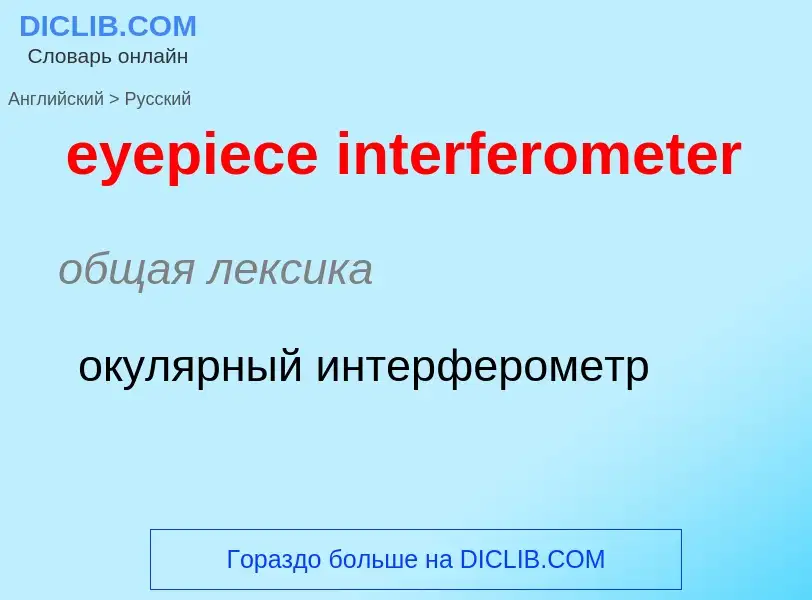eyepiece interferometer - traducción al ruso
общая лексика
окулярный интерферометр
['klaiəu]
существительное
общая лексика
«Клио»
премия «Клио» (ежегодно присуждается лучшему участнику рекламных телепередач - режиссёру, актёру и т. п. в США)
мифология
Клио (муза - покровительница истории)
оптика
интерферометр Маха-Цандера
Wikipedia

The Michelson interferometer is a common configuration for optical interferometry and was invented by the 19/20th-century American physicist Albert Abraham Michelson. Using a beam splitter, a light source is split into two arms. Each of those light beams is reflected back toward the beamsplitter which then combines their amplitudes using the superposition principle. The resulting interference pattern that is not directed back toward the source is typically directed to some type of photoelectric detector or camera. For different applications of the interferometer, the two light paths can be with different lengths or incorporate optical elements or even materials under test.
The Michelson interferometer (among other interferometer configurations) is employed in many scientific experiments and became well known for its use by Michelson and Edward Morley in the famous Michelson–Morley experiment (1887) in a configuration which would have detected the Earth's motion through the supposed luminiferous aether that most physicists at the time believed was the medium in which light waves propagated. The null result of that experiment essentially disproved the existence of such an aether, leading eventually to the special theory of relativity and the revolution in physics at the beginning of the twentieth century. In 2015, another application of the Michelson interferometer, LIGO, made the first direct observation of gravitational waves. That observation confirmed an important prediction of general relativity, validating the theory's prediction of space-time distortion in the context of large scale cosmic events (known as strong field tests).











![Albert Wolff]] in Berlin Albert Wolff]] in Berlin](https://commons.wikimedia.org/wiki/Special:FilePath/Statue of Clio in Berlin.jpg?width=200)
![''Clio, Muse of History'' by [[Johannes Moreelse]] ''Clio, Muse of History'' by [[Johannes Moreelse]]](https://commons.wikimedia.org/wiki/Special:FilePath/Moreelse Clio - muse of history.jpg?width=200)
![''Clio, the Muse of History'' (1632) by [[Artemisia Gentileschi]]. ''Clio, the Muse of History'' (1632) by [[Artemisia Gentileschi]].](https://commons.wikimedia.org/wiki/Special:FilePath/Gentileschi, Artemisia - Clio - 1632.jpg?width=200)
![''The Muse Clio'' (c. 1689) by [[Pierre Mignard]] ''The Muse Clio'' (c. 1689) by [[Pierre Mignard]]](https://commons.wikimedia.org/wiki/Special:FilePath/Pierre Mignard - Clio - WGA15654.jpg?width=200)
![''The Muse Clio'' by [[Bernhard Rode]] ''The Muse Clio'' by [[Bernhard Rode]]](https://commons.wikimedia.org/wiki/Special:FilePath/Christian Bernhard Rode - Die Muse Klio.jpg?width=200)
![''Car of History'', a [[chariot clock]] depicting Clio, by Carlo Franzoni, 1819, in [[National Statuary Hall]] ''Car of History'', a [[chariot clock]] depicting Clio, by Carlo Franzoni, 1819, in [[National Statuary Hall]]](https://commons.wikimedia.org/wiki/Special:FilePath/Car of history.jpg?width=200)
![Sculpture of Clio by [[Alexander Stirling Calder]] on the tomb of historian [[Henry Charles Lea]] Sculpture of Clio by [[Alexander Stirling Calder]] on the tomb of historian [[Henry Charles Lea]]](https://commons.wikimedia.org/wiki/Special:FilePath/HC Lea grave LH Philly.jpg?width=200)